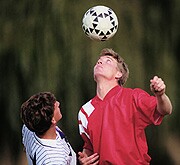
THURSDAY, April 10 (HealthDay News) — High school athletes who suffer from concussions are complying more with the recommended return-to-play guidelines, according to new research.
Compliance was tracked from 2005 through 2013, using a database of high school sports-related injuries, said Dr. Mark Riederer, a clinical fellow in primary care sports medicine at Children’s Hospital Colorado. Compliance began to improve, especially around 2008, he said.
“In 2007 we had just above 50 percent of athletes noncompliant,” he said. “In 2012-2013, it looked like 20 percent. We think that’s excellent.”
A concussion is any brain injury that upsets normal functioning. Concussions are often caused by a blow to the head, frequently in collision sports such as football or ice hockey, according to the American Academy of Pediatrics.
Riederer was due to present the study findings this week at the annual meeting of the American Society for Sports Medicine in New Orleans. Studies presented at medical meetings are typically viewed as preliminary until published in a peer-reviewed journal.
He obtained the data from a national compilation of sports-related injuries reported by U.S. high schools. He looked to see if the athletes complied with a set of commonly used guidelines known as the Zurich return-to-play guidelines.
For the study, the athletes were considered compliant if they waited to return to play six or more days after their symptoms resolved.
The improvement in compliance, Riederer said, can probably be traced to many factors. These include increased awareness from parents, athletes, coaches and doctors of the importance of treating concussions, as well as the increase in concussion laws spelling out what should be done when an athlete suffers a concussion.
More parents and athletes are being educated before sports participation, he said, including facts about the risks of a second concussion without enough recovery time. All 50 states and the District of Columbia now have some kind of state law on youth concussions, protecting athletes from returning to play too soon, he said.
In some states, parents get a handout explaining the seriousness of a concussion and what should be done. “Some states require a signature on file that both parents and athletes have received this,” he said.
Children who have a concussion should be evaluated by a health care professional and cleared before returning to sports, according to Riederer and other experts.
The new study does demonstrate that athletes are getting better at complying with the guidelines, said Dr. John Kuluz, director of traumatic brain injury and rehabilitation at Miami Children’s Hospital, who reviewed the findings.
However, he said, the survey did not include athletes in non-school programs, so it may not be an accurate reflection.
Many students play in leagues, he said, and on other non-school-related teams. “I suspect, if you look at all concussions, noncompliance [with guidelines] is a lot higher,” he said.
In another presentation at the meeting, researchers from Rutgers University in New Jersey also suggested that there’s room for improvement. They surveyed 79 freshman and 89 junior athletes from an NCAA Division I university about concussions. While 73 percent of the freshmen said it was acceptable to “tough it out” during a game if you suspect you have a concussion, 85 percent of juniors did.
More juniors than freshmen reported having symptoms of concussion. That may mean they have more concussions or they are more aware of the symptoms, the researchers said.
Whichever the implication, Kuluz said, the survey also indicates there is room for improvement.
More information
To learn more about concussions, visit the American Academy of Pediatrics.
Copyright © 2025 HealthDay. All rights reserved.

